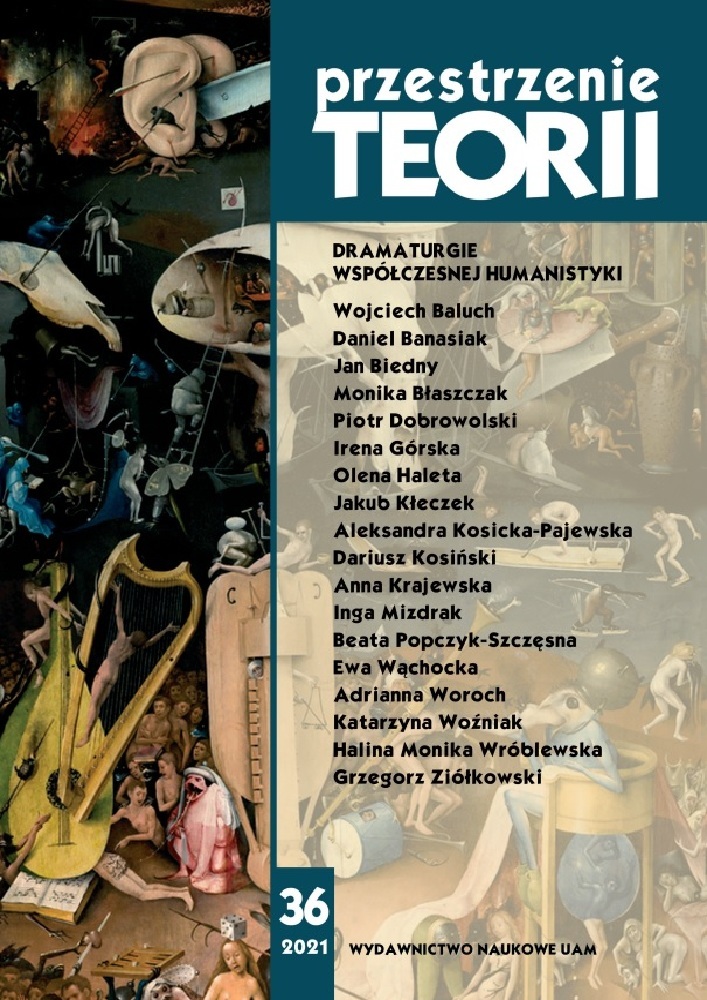Abstract
The paper aims to answer the question – to what extent is the current reflection on user experience design in performing arts still valid? The text discusses the concept of post-digital performance (Causey); and the phenomenon of user experience design in the face of new media dramaturgy (Eckersall, Grehan, Scheer). From the perspective of these concepts and phenomena, I describe two works (To Like or Not to Like by Interrobang and Karen by Blast Theory). The text complements the discussion on performance artists’ approaches to media technologies. In this paper, I describe the changes in designing the relationships of performers and users (individualization and personalization) and the contexts of everyday media practices in artists’ strategies.
References
Archey K., Peckham R., Art Post-Internet, http://ucca.org.cn/en/exhibition/art-post-internet/ (dostęp: 30.03.2021).
Birringer J., Performance, technology, and science, New York 2008.
Broadhurst S., Digital Practices, Basingstoke 2011.
Butler A., Affective Encounter: Repetition and Immersive Practices in Man of Valour,„Rhizome. Cultural Studies in Emerging Knowledge” 2019, nr 35, www.rhizomes.net/issue35/butler/index.html (dostęp: 30.03.2021).
Carr N., Płytki umysł. Jak internet wpływa na nasz mózg?, przeł. K. Rojek, Gliwice 2013.
Causey M., Postdigital Performance, „Theater Journal” 2016, nr 3.
Causey M., Theatre performance and technology, London 2006.
Chatzichristodoulou M., Karen by Blast Theory: Leaking Privacy, [w:] Digital bodies, red. S. Broadhurst, S. Price, London 2017.
Davies E., Experience Design (And the Design of Experience), https://www.academia.edu/11656018/Experience_Design_And_the_Design_of_Experience_ (dostęp: 30.03.2021).
Dixon S., Cybernetic-existentialis, London – New York 2020.
Dixon S., Digital Performance, Cambridge 2007.
Eckersall P., Grehan H., Scheer E., New Media Dramaturgy, London 2017.
Ferrando F., Philosophical posthumanism, London – New York 2020.
Gere C., Digital Culture, London 2008.
Ilter S., Unsettling the ‘friendly’ gaze of dataveillance: the dissidentpotential of mediatised aesthetics in Blast Theory’s Karen, „International Journal of Performance Arts and Digital Media” 2017, nr 1.
Klich R., Intermedial Theatre. On Technology, [w:] Intermedial Theatre. Principles and Practices, red. M. Crossley, London 2019.
Kluszczyński R.W., Can You See Me Now? (2001) Blast Theory, [w:] Klasyczne dzieła sztuki nowych mediów, red. P. Zawojski, Katowice 2015.
Kłeczek J., Historycznomedialne przemiany scenotechniki, notacji i podmiotowości w sztukach performatywnych, Poznań 2018 (praca doktorska), https://hdl.handle.net/10593/23952 (dostęp: 30.03.2021).Laurel B., Computers As Theatre, New York 1991.
Lehmann H.-T., Teatr postdramatyczny, przeł. D. Sajewska, M. Sugiera, Kraków 2009.
McHugh G., Post Internet. Notes on the internet and art 12.29.09> 09.05.10, Brescia 2011.
Mee E.B., The Audience Is the Message: Blast Theory’s App-Drama Karen, „TDR/The Drama Review” 2016, nr 3.
Parker-Starbuck J., Cyborg theatre, New York 2014.
Postdigital Aesthetics. Art, Computation and Design, red. D.M. Berry, M. Dieter, Basingstoke 2015.
Salter C., Entangled, Cambridge 2010.
Spence J., Performative Experience Design, Cham 2016.
Spence J., Andrews S., Frohlich D.M., Performative Experience Design, [w:] CHI2013 Changing perspectives, red. P. Baudisch, M. Beaudouin-Lafon, W.E. Mackay, Paris 2013.
The Performing Subject in the Space of Technology. Through the Virtual, Towards the Real red. M. Causey, E. Meehan, N. O’Dwyer, London 2015.
License
Authors
Authors of texts accepted for publication in Przestrzenie Teorii are required to complete, sign and return to the editor's office the Agreement for granting a royalty-free license to works with a commitment to grant a CC sub-license.
Under the agreement, the authors of texts published in Przestrzenie Teorii grant the Adam Mickiewicz University in Poznań a non-exclusive, royalty-free license and authorize the use of Attribution-NonCommercial-NoDerivatives 4.0 International (CC BY-NC-ND 4.0) Creative Commons sub-license.
The authors retain the right to continue the free disposal of the work.
Users
Interested Internet users are entitled to use works published in Przestrzenie Teorii since 2015, for non-commercial purposes only, under the following conditions:
- attribution - obligation to provide, together with the distributed work, information about the authorship, title, source (link to the original work, DOI) and the license itself.
- no derivatives - the work must be preserved in its original form, without the author's consent it is not possible to distribute the modified work, such as translations, publications, etc.
Copyrights are reserved for all texts published before 2015.
Miscellaneous
Adam Mickiewicz University in Poznań retains the right to magazines as a whole (layout, graphic form, title, cover design, logo etc.).

